Moniek Bloks's Blog, page 58
February 1, 2024
The Cullinan IX Ring
The Cullinan IX ring consists of a “pear-shaped diamond in open-work 12-claw setting, with plain loop.”1
Embed from Getty ImagesThe Cullinan IX was the smallest of the stones cut from the Cullinan diamond. This diamond was given to Queen Mary in 1910 by the government of South Africa.
Queen Mary had it set in a ring, which was bequeathed to Queen Elizabeth II in 1953, alongside the other Cullinan diamonds.
It is one of the least worn of the Cullinan diamonds but can be seen in the 1984 portraits by Yousuf Karsh.
The post The Cullinan IX Ring appeared first on History of Royal Women.
January 30, 2024
Mencía de Mendoza – The Spanish Countess of Nassau
Mencía de Mendoza y Fonseca was born on 30 November 1508 as the daughter of Rodrigo Díaz de Vivar y Mendoza, 1st Marquis of Cenete and María de Fonseca y Toledo. She was probably born at Jadraque Castle and baptised at the nearby Our Lady of Castrejón.
Her early years were spent at the fortress of Ayora, where she was joined by two younger sisters named Maria and Catherine. It was likely a happy childhood and her parents’ marriage had been a love match. Her mother died sometime in 1522 and her father died after a four-day fever on 22 February 1523.1 Her parents were buried together at the Holy Trinity convent in Valencia and Mencia was given permission by Charles V, Holy Roman Emperor to erect a grand mausoleum there.
Mencía and her sisters were declared their father’s heirs on 3 June 1523, which made Mencia the new Marchioness of Cenete. Charles also had the right to decide her marriage and he did not wait for very long. Already on 20 March 1523, Henry III, Count of Nassau, wrote to his brother Willia that the Emperor had suggested her to him. He wrote, “She is a rich heiress, 15 or 16 years old, and I am told, rather pretty.”2 William was delighted and told him to marry Mencía. Henry was 41 years old and had been married twice before.
After some financial negotiations, Mencía and Henry were officially betrothed on 27 June 1524 in the presence of the Emperor, and his sister Eleanor. The wedding ceremony took place on 30 June and Mencía became the stepmother of Henry’s son from his second marriage, René of Châlon. This marriage between a Dutch and Spanish noble was an attempt from Charles to mix the nobility, an experiment that turned out to be not quite as successful as hoped. And despite her wealth, Henry took offence to Mencía’s father, who had been born the illegitimate son of Cardinal Pedro González de Mendoza.
Mencía had fallen pregnant rather quickly but the pregnancy ended in a miscarriage after three months, as was reported on 15 November 1524. Apparently, she had overexerted herself during a game with her ladies. She would suffer at least one more miscarriage and she gave birth to a boy after a pregnancy of seven months. The boy lived for just two hours and was baptised during this time.
In February 1526, Mencía was in the company of Germaine of Foix, the widow of King Ferdinand II of Aragon, and they travelled with the Emperor’s sister Leonor to the French border as Leonor was to wed the French King. In the end, the wedding was postponed and would not take place until 1530.
On 24 June 1526, Henry and Mencía departed for the castle of Lacalahorra in Cenete, although she clearly returned to the Spanish court often, as she was present for the baptism of the future King Philip II in 1527. Her first trip to the Low Countries would take place in 1530 where she would initially stay in their palace in Brussels as the castle in Breda was being turned into a more comfortable place to live.
In 1533, Mencía accompanied Henry and her stepson to the principality of Orange, where René was received as the Prince of Orange. They then travelled to France for a meeting with King Francis I of France and Eleanor before travelling back to Spain. Mencía spent Christmas of 1533 at the Palace of Barcelona. When the Spanish court fled Valladolid because of the plague, Mencía and Henry were likely part of the royal household. By August 1534, Henry was back in the Low Countries and Mencía followed him in the summer of 1535. In March 1534, Mencia had been present at the wedding of her sister Maria to Diego Hurtado de Mendoza. Breda was now their main residence as the castle had been carefully renovated.
Mencía would live in Breda until 1539 and she mostly devoted those four years to studying. She eventually learned to read Latin and Greek, and she also enjoyed literature and philosophy. Her husband was on hand to explain Dutch sayings and paintings and she became quite the collector of art. On 13 September 1538, Mencía was widowed when Henry died at the age of 55. Mencía was soon involved in a battle for his inheritance with René. Henry had made René his universal heir and had left Mencía with just some furniture and things he had given her during their marriage.
It was Mencía’s wish to return to Spain and she did so in October 1539 in the company of one of Henry’s illegitimate sons who had been born in 1531. Just as she returned to her homeland, the Emperor had decided on a new marriage for her. The new groom was the son of the Marquess of Mondéjar but Mencía was not happy. In the end, this marriage came to nothing.
Mencía’s sister Catherine, who had been married to the Marquess of Berlanga, had died in December 1526 without having had any children. Her sister Maria, whose wedding she had attended, had given birth to eight sons and five daughters, and they were reunited upon Mencía’s return to Spain.
By 16 July 1540, it was clear that Mencía would marry Ferdinand, Duke of Calabria, the son of the dethroned King Frederick of Naples and his second wife, Isabella del Balzo. He was also the widower of Germaine of Foix, who had died in 1536. Ferdinand was the viceroy of Valencia. Nevertheless, it would take another six months for the wedding to take place. It was to be a happy marriage, but it also remained childless.
During her second marriage, she made plans to found some kind of college, but this never materialised. She continued to focus on her own studies and became quite renowned. She was also a patron of the arts. Mencía was widowed for the second time when Ferdinand died on 26 October 1550. Mencia herself died four years later on 4 January 1554. She had asked to be buried with her parents and this wish was carried out. Her sister Maria succeeded to the title of Marchioness of Cenete and the title exists to this day.
The post Mencía de Mendoza – The Spanish Countess of Nassau appeared first on History of Royal Women.
January 28, 2024
Mavia of Tanukh – The Warrior Queen who fought and defeated the Romans
Mavia (also known as Mawayia) was the Queen regnant of Tanukh. She was a warrior queen who fought and defeated both the Romans and the Goths. She proved to be a brilliant military general. Even though Queen Mavia of Tanukh was not a Christian, she helped spread orthodox Christianity throughout Arabia.[1] She also promoted women’s rights in a patriarchal society.[2]
Queen Mavia of Tanukh’s origins are unknown.[3] She was born sometime in the mid-fourth century.[4] She was a noblewoman from an Arabic semi-nomadic tribe between Syria and Hijaz (in the modern western regions of Saudi Arabia).[5] She married the king of Tanukh (a kingdom between Syria and Mesopotamia), whose name may have been al-Hawari.[6] Mavia became Queen of Tanukh. She had one daughter.[7] Her husband died in 375 C.E.[8] He had no sons and bequeathed his kingdom to his Queen.[9] Mavia became the Queen regnant of Tanukh.[10]
The Tanukh kingdom was very vulnerable to attacks because its ruler was a woman.[11] Queen Mavia had to quickly prove her military dominance to strengthen her kingdom.[12] She would prove to be a brilliant military strategist and general.[13] In a span of a few months, she conquered Arabia, Palestine, and Egypt’s Sinai region.[14] This made her wage a war against the Romans.[15] She continued to defeat a series of Roman legions.[16] She was successful because of her unity with other Arabic tribes, whereas the Roman military in the East was weak.[17] This allowed her kingdom to remain independent from Rome.[18] The reason why she waged war against the Romans was because Queen Mavia wanted her people to leave paganism and become Christians.[19] She wanted to build ties with the Romans, who were Christians and help convert her own people.[20] Thus, she believed that she could foster an alliance with the Roman Empire while still remaining independent.[21]
During her war against the Romans, Queen Mavia chose an ascetic monk named Moses as her bishop.[22] This made Moses the first bishop of an Arabic Orthodox Church and helped the unification of Arabia through religion.[23] Throughout the fifth and sixth centuries, Christianity was spread throughout the Arabic tribes that helped promote monotheism before Prophet Muhammad founded Islam.[24] Queen Mavia also allowed the noblewomen in her empire to divorce their husbands.[25] Queen Mavia also married her daughter, Princess Chasidat, to a Roman military officer named Victor.[26] This made Princess Chasidat a Roman citizen.[27] She hoped that this would maintain peace between Rome and Tanukh.[28] However, the peace was only temporary.[29]
Queen Mavia and Emperor Valens finally agreed to a truce. She became Rome’s ally.[30] Queen Mavia helped the Romans in their war against the Goths.[31] On 9 August 378 C.E., the Goths defeated the Romans and Queen Mavia’s army at the Battle of Adrianople.[32] Later that same year, the Goths marched to Constantinople, where they were met by Queen Mavia’s army.[33] Queen Mavia and her army became victorious. They drove the Goths out of Constantinople.[34] However, Queen Mavia did lose her daughter, Princess Chasidat, during the siege.[35] Nevertheless, this victory led Constantinople to become the centre of both Roman and Christian orthodoxy for a millennium.[36]
Queen Mavia’s fate is unknown after she defeated the Goths in Constantinople.[37] In 383 C.E., the alliance between Rome and Tanukh fell apart.[38] The Tanukhids rebelled against the Romans. However, it is unknown if Queen Mavia participated in the revolt.[39] Some historians believe that she had already passed away.[40] However, an inscription stated that she reigned until she died in Khanasir (a town south-east of Aleppo) in 425 C.E.[41] If this inscription is correct, then it means that her reign was over fifty years.[42]
While Queen Mavia of Tanukh is not as famous as Queen Cleopatra, Queen Boudica, and Queen Zenobia, who fought against Rome, she proved to be the most successful.[43] She was a courageous woman and military genius who proved herself on the battlefield. Queen Mavia turned her small kingdom into a massive empire. Her military victories showed how she remained uncontested in power until her death.[44] She won the respect of her people. Queen Mavia of Tanukh was a warrior queen whom the Romans feared, esteemed, and admired.
Sources:
Datta, S. R. (2021). Goddesses of Fury: History’s Most Daring Queens. The Little Booktique Hub.
El-Badawi, E. (2023, January 1). “Mavia of Tanukh Warrior queen of Arabia”. BBC History Magazine, 62.
El-Badawi, E. I. (2022). Queens and Prophets: How Arabian Noblewomen and Holy Men Shaped Paganism, Christianity and Islam. United Kingdom: Oneworld Publications.
[1] El-Badawi, 2023
[2] El-Badawi, 2023
[3] El-Badawi, 2023
[4] El-Badawi, 2023
[5] El-Badawi, 2023
[6] El-Badawi, 2022; El-Badawi, 2023
[7] Datta, 2021
[8] El-Badawi, 2023
[9] El-Badawi, 2023
[10] El-Badawi, 2023
[11] El-Badawi, 2023
[12] El-Badawi, 2023
[13] Datta, 2021
[14] El-Badawi, 2022; El-Badawi, 2023
[15] El-Badawi, 2022
[16] El-Badawi, 2023
[17] El-Badawi, 2023
[18] El-Badawi, 2023
[19] El-Badawi, 2023
[20] El-Badawi, 2023
[21] El-Badawi, 2023
[22] El-Badawi, 2023
[23] El-Badawi, 2023
[24] El-Badawi, 2023
[25] El-Badawi, 2023
[26] Datta, 2021
[27] El-Badawi, 2023
[28] El-Badawi, 2023
[29] Datta, 2021
[30] Datta, 2021
[31] El-Badawi, 2023
[32] El-Badawi, 2023
[33] El-Badawi, 2023
[34] El-Badawi, 2023
[35] El-Badawi, 2023
[36] El-Badawi, 2023
[37] El-Badawi, 2023
[38] Datta, 2021
[39] Datta, 2021
[40] Datta, 2021
[41] El-Badawi, 2023
[42] El-Badawi, 2023
[43] El-Badawi, 2022
[44] El-Badawi, 2023
The post Mavia of Tanukh – The Warrior Queen who fought and defeated the Romans appeared first on History of Royal Women.
Katherine Parr thriller “Firebrand” receives theatrical release date
The Katherine Parr thriller “Firebrand” has received a US theatrical release date.
The film is based on Elizabeth Fremantle’s novel Queen’s Gambit and focuses on her life as the sixth and final wife of King Henry VIII of England. Filming began in April 2022, and the film premiered at the 2023 Cannes Film Festival.
The synopsis reads, “In blood-soaked Tudor England, Katherine Parr, the sixth and last wife of King Henry VIII, is named Regent while tyrant Henry is fighting overseas. Katherine has done everything she can to push for a new future based on her radical Protestant beliefs. When an increasingly ailing and paranoid King returns, he turns his fury on the radicals, charging Katherine’s childhood friend with treason and burns her at the stake.
Horrified and grieving, but forced to deny it, Katherine finds herself fighting for her own survival. Conspiracy reverberates through the palace. Everyone holds their breath – for the queen to slip up, for Henry to take her head like wives before. With the hope for a future free of tyranny at risk, will Katherine submit to the inevitable for the sake of King and country?”
Alicia Vikander stars as Katherine Parr, while Jude Law stars as King Henry VIII. The film will be released in the US on 21 June 2024.
The post Katherine Parr thriller “Firebrand” receives theatrical release date appeared first on History of Royal Women.
January 27, 2024
Book News Week 5 2024
Book News week 5 – 29 January – 4 February 2024
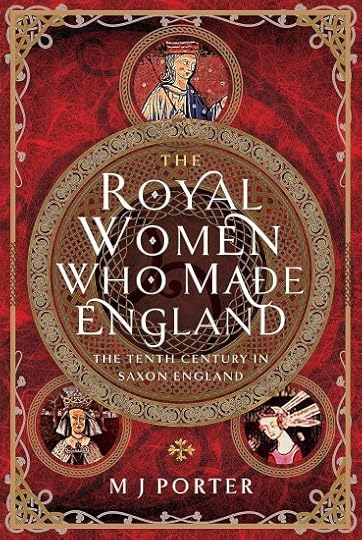
The Royal Women Who Made England: The Tenth Century in Saxon England
Hardcover – 30 January 2024 (UK)
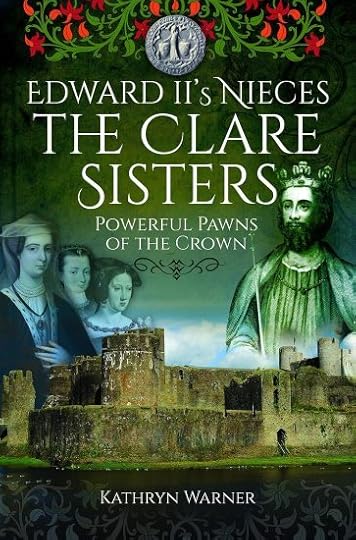
Edward II’s Nieces: The Clare Sisters: Powerful Pawns of the Crown
Paperback – 30 January 2024 (UK)
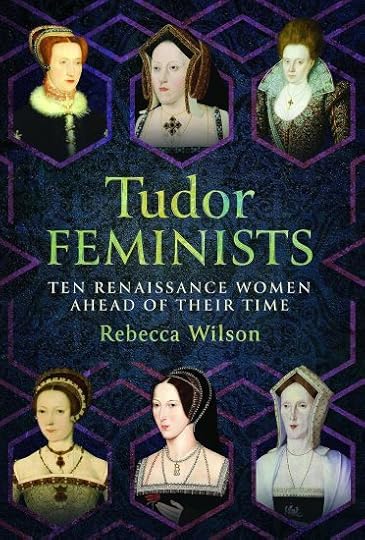
Tudor Feminists: 10 Renaissance Women Ahead of their Time
Hardcover – 30 January 2024 (UK)
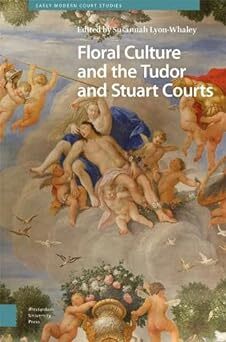
Floral Culture and the Tudor and Stuart Courts (Early Modern Court Studies)
Hardcover – 1 February 2024 (US & UK)
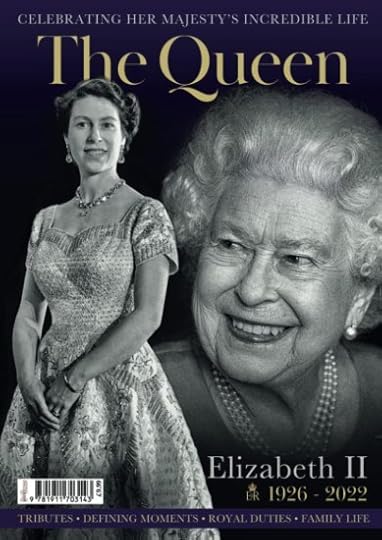
The Queen – 1926 – 2022
Paperback – 31 January 2024 (US)

The Queen: 70 Chapters in the Life of Elizabeth II
Hardcover – 1 February 2023 (US)

Henry VIII’s True Daughter: Catherine Carey, A Tudor Life
Hardcover – 1 February 2024 (US)
The post Book News Week 5 2024 appeared first on History of Royal Women.
January 26, 2024
Book Review: Cleopatra’s Daughter: Egyptian Princess, Roman Prisoner, African Queen by Jane Draycott
*review copy*
Cleopatra Selene is the forgotten daughter of the infamous Cleopatra VII. She was an Egyptian princess who was proclaimed by Marc Antony as Queen of Cyrenaica and Libya. After the death of her mother, she reigned as Queen of Egypt with her brother, Alexander Helios, for two weeks before it was annexed by the Roman Empire. She then became a Roman prisoner and lived in Emperor Augustus’s household. She went on to marry King Juba II of Mauretania, and she ruled alongside her husband.
Cleopatra’s Daughter: Egyptian Princess, Roman Prisoner, African Queen takes a closer look at his forgotten Queen, and you can tell the book has been a labour of love. Although the information on Cleopatra Selene is rather limited, Jane Draycott does her best with the means she has. We learn about the places she must have known, her illustrious parents and siblings, to try and piece together the lost information. In the end, we are stuck wanting more but knowing we’ll probably never get it.
Cleopatra’s Daughter: Egyptian Princess, Roman Prisoner, African Queen by Jane Draycott is an excellent and well-researched book. I would highly recommend it.
Cleopatra’s Daughter: Egyptian Princess, Roman Prisoner, African Queen by Jane Draycott is available now in the US and the UK.
The post Book Review: Cleopatra’s Daughter: Egyptian Princess, Roman Prisoner, African Queen by Jane Draycott appeared first on History of Royal Women.
January 25, 2024
The King Luis Diamond Tiara
The King Luis Diamond Tiara was a wedding gift from King Luís I of Portugal to Amélie of Orléans upon her marriage to his son, the future King Carlos I of Portugal. It consisted of diamonds set in silver and gold with a fleur-de-lis motif and rows of diamond necklaces.
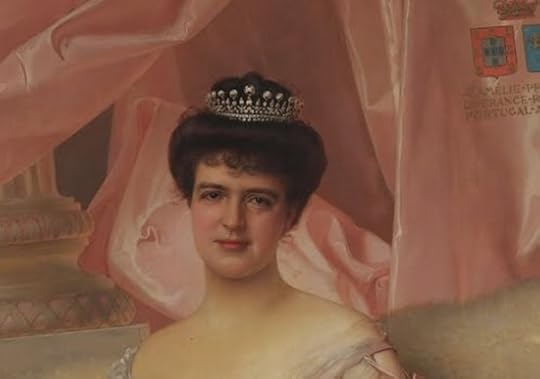 Queen Amélie with the tiara
Queen Amélie with the tiaraIt remained in her property when the monarchy was abolished in 1910. Upon her death in 1951, she left it to her godson, Duarte Pio, Duke of Braganza, who is the current pretender to the throne of Portugal.
Duarte Pio married Isabel Inês Castro Curvelo de Herédia in 1995 and she wore the tiara on her wedding day.
 (Screenshot/Fair Use)
(Screenshot/Fair Use)And then it was her daughter’s turn to wear the tiara. Infanta Maria Francisca, Duchess of Coimbra, wore the tiara on 7 October 2023 when she married Duarte de Sousa Araújo Martins in Mafra, Portugal. She is currently third in the defunct line of succession to the Portuguese throne.
The post The King Luis Diamond Tiara appeared first on History of Royal Women.
January 23, 2024
Joanna of Austria – The neglected Grand Duchess
Joanna of Austria was born on 24 January 1547 in Prague as the daughter of Ferdinand I, Holy Roman Emperor and Anna of Bohemia and Hungary. Tragically, her mother died three days of childbirth complications, and thus, Joanna never knew her mother. Joanna had 14 siblings, of which three had already passed by the time of her birth.
Joanna grew up at the Habsburg court and divided her time between Vienna and Innsbruck. She was apparently rather slow to develop and was known for her small stature. She was still quite young when she became part of marriage negotiations. Cosimo I de’ Medici, Grand Duke of Tuscany, inquired after her for his eldest son, Francesco, who was six years older than her. In the midst of the negotiations, her father died, which delayed them somewhat. In early 1565, negotiations were concluded, and Francesco came to Innsbruck to meet his future wife.
He came bearing gifts for Joanna and her brother, Maximilian, who had succeeded their father as Holy Roman Emperor. On 16 December 1565, Joanna made her grand entry into Florence and the wedding was celebrated just two days later. It was an unhappy marriage from the start and Francesco continued his love affair with Bianca Capello.
Despite this, Joanna quickly fell pregnant and gave birth to a daughter named Eleanor on 28 February 1567. This was quickly followed by another daughter, named Romola, who was born on 20 November 1568 and who lived for just a few days. On 31 December 1569, she gave birth to a third daughter, named Anna. When her father-in-law remarried Camilla Martelli in 1570, her husband was opposed and he wrote to Joanna that she shouldn’t be friends with her. Here, Joanna apparently displayed a great diplomatic skill as she managed to improve the relationship between father and son, but also between the de’ Medici family and her own family.
Any improvement in her own relationship with Francesco was short-lived when she gave birth to two more daughters, Isabella and Lucrezia, who both died young. Her father-in-law personally intervened and told Joanna to be more accepting of Francesco’s lover Bianca. She, in turn, became even more religious than she already was and she went on a pilgrimage to Loreto in 1573.
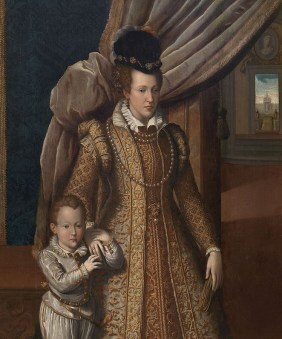 Joanna and her son (public domain)
Joanna and her son (public domain)On 21 April 1574, her father-in-law died, making her husband the new Grand Duke of Tuscany, and she his Grand Duchess. Francesco no longer cared about being discreet with Bianca and the birth of yet another daughter, named Maria, did nothing to improve their relationship. In 1576. Bianca gave birth to a son named Antonio. That same year, Joanna reportedly contacted her brother and asked to be allowed to return to Vienna on account of her husband’s neglect. Maximilian did protest his sister’s treatment but there could be no question of her return home to Vienna.
Then, at last, Joanna gave birth to a son named Filippo. However, the boy appeared to be weak and sickly but the birth of an heir meant that her position at court was strengthened. It wasn’t to last for very long, as Joanna tragically died following childbirth on 11 April 1578. 1 An autopsy showed that Joanna had died after her uterus ruptured and the fetus had passed into the abdominal cavity.
Joanna was buried in the New Sacristy in the Basicila of San Lorenzo in Florence and her body was exhumed in 1857 when all those there were moved to the Medici Chapel. In 1947, her body was studied by a group of anthropologists. Once again, in 2003, Joanna’s body was studied as part of a larger study into a total of 12 members of the de’ Medici family.
Joanna’s skeleton was described as having an anthropological age of 25-35 years, 1.57 m in height, with a middle-low skull and orbits, and a narrow face and nose. She had a “serious scoliosis of the lumbar spine and a bilateral congenital subluxation of the hip.”2 Her pelvis bore evidence of several difficult deliveries and she had a deformity in the serious S-scoliosis of the lumbar spine. Together with the deformity of the pelvis, this would have explained her difficult deliveries and the rupture of the uterus.
Joanna’s husband wasted no time after her death and he married Bianca two months later. While their son died young, her daughter Marie became Queen of France as the wife of King Henri IV of France.
The post Joanna of Austria – The neglected Grand Duchess appeared first on History of Royal Women.
January 21, 2024
Catherine of Austria – Pain and anguish (Part four)
Catherine’s regency needed the assistance of her brother-in-law, Henry, if only because she was still considered a foreigner after all these years. Catherine was fully aware of the difficulties ahead as she wrote to her brother. Meanwhile, the young King was growing up in Catherine’s household. When his mother Joanna was released from the regency in 1559, she wanted to return to Portugal. However, “Queen Catherine had already given more than enough proof that she was not the type of woman to withdraw easily from the political life.”1 In 1562, Catherine proposed to sign the regency over to her brother-in-law completely, although she remained Sebastian’s guardian.
The following year, he was moved to his own household, and he was separated from his grandmother for the first time in his life. Sebastian continued to visit her every day, and she questioned him about his studies. Nevertheless, she felt a strong pull towards a retirement in a convent, but she never actually took that step. In 1564, Catherine’s brother Ferdinand died, leaving her as the sole surviving sibling.
On 20 January 1568, Sebastian celebrated his 14th birthday, and he no longer required a regent. Catherine stood by his side during the official ceremony, and she was the first to kiss his hand. However, their relationship had become more distant over the last few years. One observer wrote, “I believe that [King Sebastian] finds the Queen’s yoke a great nightmare and that not only in government, but also in company, he wishes to break away, and I have no doubt that in time he will try to do so.”2 Catherine slowly withdrew from politics and repeated her threat to retire to a convent. She was also troubled by the news of her other grandson, Charles, who was locked away by his father around this time. He died on 24 July 1568 at the age of 23, leaving no children. Catherine had begged Philip to care for Carlos herself and offered to travel to Spain to do so, but it was too late. This left Sebastian as her sole descendant, and he was actively avoiding her.
In 1569, one observer wrote, “His Highness has astonished the people both of his kingdom and of the others, who knew that he [Sebastian] had done something so unworthy of his person, and of the great obligation he owes to the Queen […] not to have seen her in four months or so and even more so in such a time [of plague].”3 Meanwhile, King Philip wrote to her that she was welcome to come to Spain and to “choose the place that is most to your liking.”4 There was an emotional meeting between grandmother and grandson, which left both in tears. She later wrote that it was the influence of her brother-in-law, Henry, that was making her want to leave.
Nevertheless, she stayed in Portugal, but she did retire to the palace of Xabregas. In 1571, she wrote, “The most beloved thing I have in my life is the King, my grandson. From all the children I had with the King, my lord, God left me with nothing else to set my eyes and heart on.”5 Catherine began to focus on the completion of the tombs of her husband’s parents, her husband and her own at the Jerónimos Monastery. Even this caused friction with her brother-in-law, who was mad that his parents were to be buried on the left “less noble” side. Catherine had paid for this herself and thus felt entitled to the right “more noble” side. Ultimately, the Cardinal won, with Catherine writing that she wanted to “conform to his opinion rather than appear stubborn in mine.”6
Sebastian had begun to develop an interest in a crusade to Morocco, which worried Catherine as he had not yet married and fathered an heir. Several marriage options had already been discussed for him, such as Isabella Clara Eugenia, the eldest daughter of King Philip II of Spain, and his third wife, Elisabeth of Valois. He remained reluctant to marry and “shows so much hatred towards women, that he takes his eyes off them and if a lady serves him a glass, he tries to take it without touching her.”7
On 7 September 1573, Sebastian’s mother, Joanna, died at the age of 38 after a long and painful illness. Sebastian only became more focused on his crusade. He left for the Algarve, although Catherine feared it was his intention to go to Africa. She was in “a lot of pain and anguish.”8 She was right, and he indeed went to Morocco. He would not return for many months, and it was feared that he had died. When he finally entered Lisbon on 30 November 1574, he was received by cheering crowds.
As Catherine turned 67, she began to feel her ailing body, and she had her will drawn up. She lived for another four years. She had written her last letter on 1 January 1578 to her nephew, King Philip II of Spain. She once again noted that her desire – the marriage of Sebastian and Isabella Clara Eugenia – would likely not take place. She suffered from fevers shortly before her death and received a visit from her grandson on 13 January. He was planning another crusade to Africa as his grandmother was undergoing bloodletting. She was informed of his plans shortly before her death, and one observer wrote, “Although Queen Catherine concealed it, I felt it go through her heart.”9
She began to fall in and out of unconscious on the 10th, and on the 11th, she received the last rites. Sebastian arrived to say goodbye, but she was no longer able to speak, and she did not appear to recognise him. Nevertheless, he was by her side when she died on 12 February 1578 at the age of 71.
Her worst fear came true just six months later. Sebastian disappeared and was most likely killed during a battle in Morocco. He was 24 years old and left no children, which meant that Catherine’s line became extinct. His uncle, Henry, became King of Portugal, but the Cardinal was not released from his ecclesiastical vows, and upon his death, a succession crisis broke out.
The post Catherine of Austria – Pain and anguish (Part four) appeared first on History of Royal Women.
January 20, 2024
Book News Week 4 2024
Book News Week 4 – 22 January – 28 January 2024
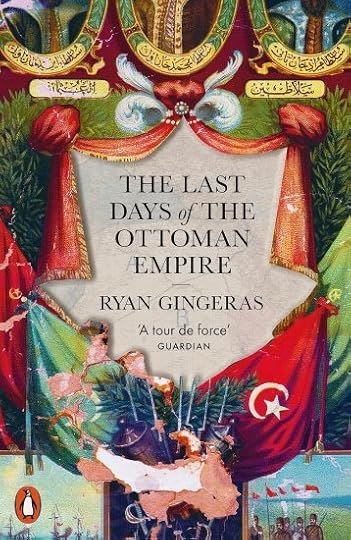
The Last Days of the Ottoman Empire
Paperback – 25 January 2024 (UK)
[no image yet]Akkadian Royal Letters in Later Mesopotamian Tradition
Hardcover – 25 January 2024 (US)

Diana: Remembering the Princess
Paperback – 23 January 2024 (US)
The post Book News Week 4 2024 appeared first on History of Royal Women.



